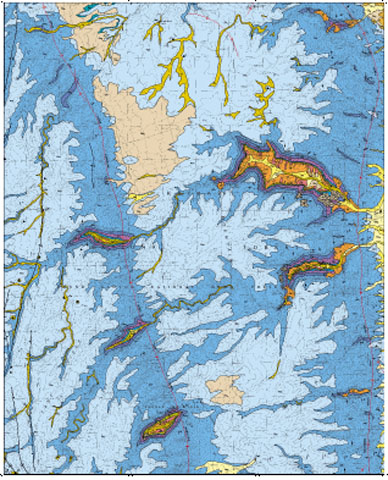

This illustration is a non-navigable .gif image of the USGS geologic map plot of the Cane quadrangle. A full-size, navigable map graphic can be plotted from the PostScript file (canemap.eps). Note: the full-size plot
is approximately 29 x 30 inches in size, requires a large-format plotter, and is best reproduced at 600 (or greater) dpi.
This geologic map is part of a cooperative project between the U.S. Geological Survey and the Kaibab National Forest Service to provide geologic information for the Paradine Plains Cactus (Pediocactus pardinei B, W. Benson, 1957) Conservation Assessment and Strategy conducted by the Kaibab National Forest, Williams, Arizona. The map area lies within the Kaibab Plateau, a sub-physiographic province of the Colorado Plateau. This map and report completes one of several areas where uniform quality geologic mapping is needed. The geologic information in this report may be useful toward land management, range management, and flood control programs for federal, state, and private agencies.
The map area is entirely within the North Kaibab Ranger District and the Grand Canyon National Game Preserve of the Kaibab National Forest. The nearest settlement is Jacob Lake about 19 km (12 mi) northwest of the map area (see fig. 1). Elevations range from about 2,500 m (8,200 ft) on the Kaibab Plateau, southwest corner of the map area, to about 1,645 m (5,400 ft) near the mouth of Seegmiller Canyon, northeast corner of the map area. Primary vehicle access is by U.S. Forest Service dirt roads that connect to U.S. Highway 89A, just north of the map area, and Highway 67 from Jacob Lake to the North Rim of the Grand Canyon. Four-wheel-drive roads access most of the map area and dirt roads are not passable in winter snow conditions.
The North Kaibab Ranger District in Fredonia, Arizona manages the National Forest lands within the map area. Other lands include Cane Ranch, a quarter section of private land at the mouth of Cane Canyon, along the east central edge of the map area (U.S. Department of the Interior, 1993). Lower elevations support a sparse growth of cactus, grass, and a variety of desert shrubs. Sagebrush, grass, cactus, cliffrose, pinion pine, juniper, ponderosa pine, and oak trees thrive at around 1,830 to 2,134 m (6,000 to 7,000 ft). Spruce, douglas fir, white pine, aspen trees, and grasses thrive at elevations above 2,228 m (7,500 ft).
Surface runoff in the map area drains eastward eroding deep canyons into the upper and lower segments of the East Kaibab Monocline. These drainages continue east toward House Rock Valley, just east of the map area, and eventually into Marble Canyon of the Colorado River at Mile 17 (17 miles downstream from Lees Ferry, Arizona).
canemap.pdf PDF (Portable Document Format) file of the map sheet for viewing onscreen (2.1 MB).
canemap.eps EPS (Encapsulated PostScript) file of the map sheet designed for plotting on a large format plotter. The map is 34 x 34 inches in size (50 MB).
canegeo.pdf PDF file of the accompanying map pamphlet for viewing and printing (132 kb).
canegeo.txt An ASCII text file of accompanying map pamphlet (44 kb).
canepdf.zip WinZipped file containing two PDF files; the map sheet and the accompanying pamphlet< (1.6 MB).
caneps.zip WinZipped file containing two files; the map sheet as an EPS file and the accompanying pamphlet as a Microsoft Word document (5.8 MB).
readme.txt An ASCII text file explaining contents of digital database and all other files that make up this publication (4 kb).
cane.met.txt FGDC-compliant metadata for the database. An additional copy of this file is included with the WinZipped compilation of the database (32 kb).
canedb.zip WinZipped compilation of all files necessary to recreate the database originally assembled in Arc/Info. Included is an AML called import.aml that will automatically import the Arc export files making up this database package (3.1 MB).
cane.style ArcMp style for map colors and symbolizing data (528 kB).
Mf2366_shapefiles.zip Shapefiles and readme describing content of each file (2 MB).
For questions about the scientific content of this report, contact George Billingsley
Download a free copy of Adobe Reader
This report is available via print on demand.
| Help
| PDF help |
| Publications main page
| Miscellaneous Field Studies Maps |
| Department of the Interior
| U.S. Geological Survey |
| Geologic Division
| Western Earth Surface Processes Team|
| Privacy Statement
| Disclaimer
| Accessibility |
URL of this page is:
https://pubs.usgs.gov/mf/2001/2366/
Please send comments and suggestions, or report problems, to:
Michael Diggles
Created: July 2, 2001 (cad)
Updated: June 4, 2007 (bwr, mfd)